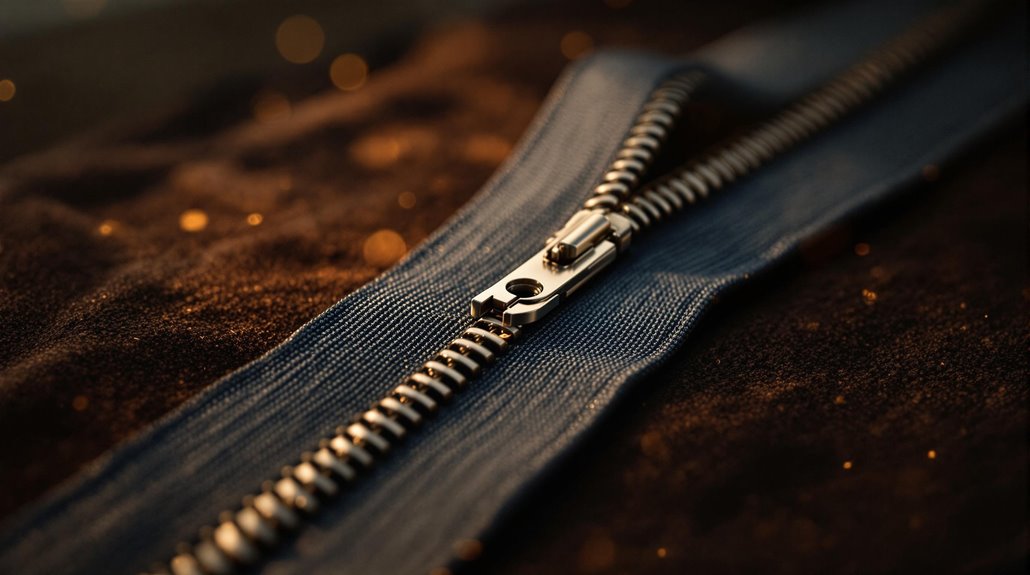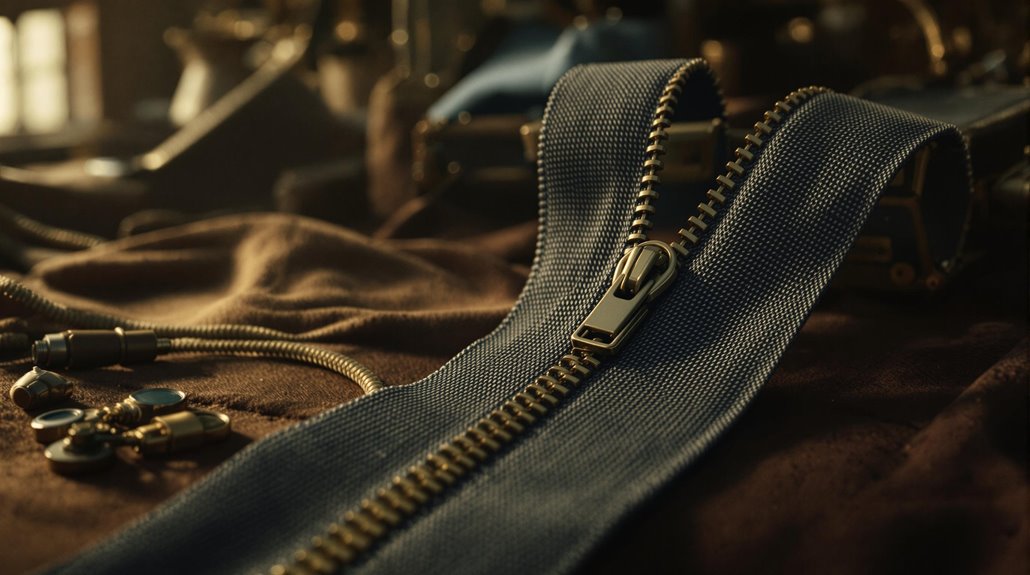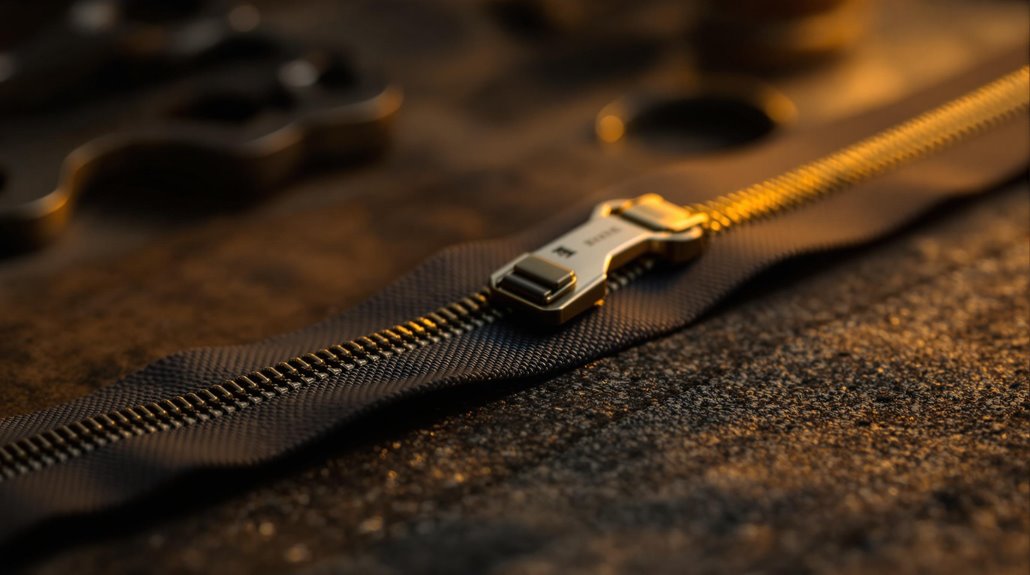Gideon Sundback’s “Hookless #2”: The Zipper Upgrade That Made Buttons Nervous
Picture a cold morning in 1914, as inventor Gideon Sundback slides the first perfectly functioning zipper up and down his workbench. You've probably never given much thought to the humble zipper, but this moment marked a quiet revolution in how we dress. What started as a simple quest to improve upon clumsy fasteners would soon challenge the centuries-old reign of buttons, transforming everything from military uniforms to evening gowns. There's more to this story of innovation than meets the eye.
The Ingenious Mind Behind the Modern Zipper

While many take the humble zipper for granted, its modern form emerged from the brilliant mind of Swedish-American inventor Gideon Sundback. Born in 1880 on a Swedish farm, he'd lay the groundwork for one of fashion's most revolutionary innovations after moving to America in 1905.
Sundback's innovations began at Universal Fastener Company, where he quickly rose to head designer. His marriage to the plant manager's daughter, Elvira Aronson, coincided with his most productive period of fastener evolution. The innovation of placing two rows of teeth facing each other proved to be a crucial breakthrough. It took twenty years of development before the zipper became a truly practical product for everyday use.
You can trace his progress from the "Plako" in 1908 to the groundbreaking "Hookless #1" in 1912, culminating in the "Hookless #2" – the modern zipper design – in 1913. His invention wasn't just about the design; he also created the S-L machine in 1923, making efficient zipper manufacturing possible.
Breaking Down the "Hookless #2" Design
Sundback's revolutionary "Hookless #2" design transformed the zipper from a novelty into a practical necessity through four key innovations.
You'll find the first breakthrough in its increased tooth density, where he packed 10-11 fastening elements per inch instead of just 4. This higher density didn't just create a stronger closure – it made the zipper more water-resistant and smoother to operate. After working as head designer at Universal Fastener Company, Sundback perfected this groundbreaking design.
The second game-changing feature was the interlocking mechanism, which added an indent and bump to each tooth. When you zip up your jacket today, you're benefiting from this clever design that prevents accidental openings and helps the zipper reconnect if separated.
Combined with the Y-shaped slider and the efficient "S-L" manufacturing process, these innovations created the reliable fastener you use every day. The design proved so successful that by 1918, the U.S. Navy purchased 10,000 fasteners for their flight suits.
From Military Belts to Fashion: Early Applications
Despite initial skepticism from the fashion industry, the zipper's journey to widespread adoption began with the military.
You'll find that military innovation drove early acceptance, with the Navy ordering 10,000 hookless fasteners for flight suits in 1918. The Army Air Service and other branches soon followed, using zippers on money belts and life vests. Gideon Sundback, as lead designer, helped revolutionize military uniforms with his innovative fastening system.
Civilian adoption started modestly, with B.F. Goodrich introducing zipped rubber boots in the 1920s and coining the term "zipper." Tobacco pouches became another early commercial success. The growing success was thanks to the innovative scrapless manufacturing machine that could produce zippers efficiently and without waste.
However, you wouldn't have found many zippers in clothing stores, as manufacturers and the public remained hesitant. Religious opposition even labeled them "the Devil's fingers."
It wasn't until after World War II that zippers truly conquered fashion, with Talon's sales reaching $30 million by 1941.
The S-L Machine Revolution in Manufacturing
The evolution of zipper manufacturing took a giant leap forward with the introduction of the Large Additive Subtractive Integrated Modular Machine (LASIMM).
This hybrid manufacturing system, developed through EU's Horizon 2020 program, has revolutionized how you'll see zippers being produced today.
You'll find that LASIMM's combination of additive machining and industrial robotics can handle components up to 6 meters long and 2000kg in weight.
The system's precision and efficiency have cut production time by 20% while boosting productivity by 15%.
Similar to the separated vibration motors in modern block making machines, LASIMM's innovative design helps minimize operational noise and extend equipment lifespan.
What's more, you're looking at significant reductions in inventory and floor space requirements.
Developed through ten collaborative organizations across six European countries, LASIMM represents a milestone in manufacturing innovation.
With its advanced metrology and inspection capabilities, LASIMM's impact extends beyond just zipper production – it's setting new standards for manufacturing customization across multiple industries, from aerospace to construction.
The Great Button vs. Zipper Showdown

When old-world tradition clashed with modern innovation, the button-versus-zipper rivalry became one of fashion's most fascinating showdowns.
The fastening technology battle reached its peak in 1937, when the zipper finally gained the upper hand in men's trousers. Originating in the 1870s, Levi Strauss pioneered the button fly design. Today's manufacturers still produce less prone to breaking button fly options for those seeking maximum durability.
You'll appreciate how this fashion evolution played out, with each side offering distinct advantages:
- Buttons brought durability, classic style, and easy replacement
- Zippers provided streamlined looks and faster dressing
- Traditional buttons offered more decorative possibilities
- The zipper's modern convenience particularly helped children and elderly
The verdict came when French designers and Esquire magazine endorsed zippers as the superior choice for men's clothing.
With promises of preventing "embarrassing disarray" and offering sleeker style, the zipper's victory in the "Battle of the Fly" marked a turning point in clothing fastener history.
A Century of Sliding Success: Global Impact and Recognition
From humble beginnings as a novelty fastener, today's zipper industry has evolved into a $13.6 billion global powerhouse that touches nearly every aspect of modern life.
You'll find sliding mechanisms everywhere, from your favorite jeans to high-tech military gear, showcasing zippers' evolution from simple clothing fasteners to essential industrial components.
Industry giants like YKK and SBS are reshaping the future with eco-friendly innovations. The industry's focus on self-repair mechanisms has revolutionized product longevity and consumer satisfaction.
 German patent secured in 1909 laid the foundation for modern zipper manufacturing.
German patent secured in 1909 laid the foundation for modern zipper manufacturing.
You're probably wearing their products right now – whether it's a Natulon® zipper made from recycled plastic bottles or a GRS-certified sustainable fastener.
With the market projected to reach $26.8 billion by 2033, you're witnessing a revolution that extends far beyond fashion.
North American and European manufacturers dominate the industry, leading the charge in both technological advancement and environmental stewardship.










